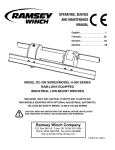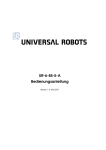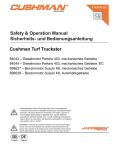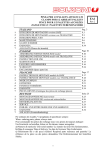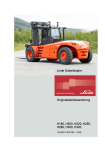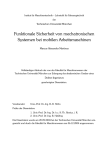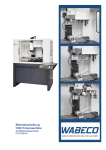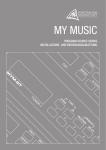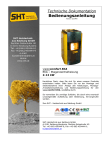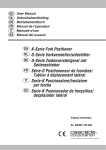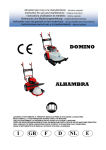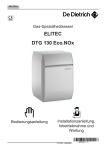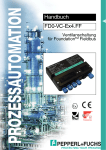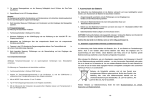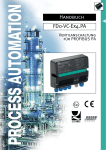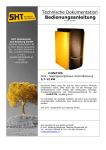Download 794044_40-55E Sideshifter Service
Transcript
EN FR DE Service Manual Manuel d' Entretien Wartungsanleitung E-SERIE/SERIE-E (40E/55E) EN FR DE Quick-Mount™ Sideshifters Tablier à déplacement latéral à montage rapide Schnell-Montage Seitenschieber Nº 794044 ® Cascade is a registered Trade Mark of Cascade Corporation Contents INTRODUCTION, SECTION 1 Special Definitions INSTALLATION INSTRUCTIONS, SECTION 2 Truck Requirements Recommended Hydraulic Supply Sideshifter Installation PERIODIC MAINTENANCE, SECTION 3 TROUBLESHOOTING, SECTION 4 General Procedures Plumbing Hosing Diagram Circuit Schematics Sideshift Circuit SERVICE, SECTION 5 Sideshifter Removal Bearings Bearing Lubrication Bearing Service Cylinder Cylinder Removal Cylinder Disassembly Cylinder Inspection Cylinder Reassembly SPECIFCATIONS, SECTION 6 Hydraulics Auxiliary Valve Functions Truck Carriage Torque Values Table des Matières Page 2 2 4 4 4 5 8 10 10 12 12 12 12 14 14 16 16 16 18 18 20 20 22 24 24 24 25 25 INTRODUCTION, SECTION 1 Définitions particulières INSTRUCTIONS D’ INSTALLATION, SECTION 2 Caractéristiques exigées du chariot Alimentation hydraulique recommandée Installation du Déplacement latéral ENTRETIEN PERIODIQUE, SECTION 3 RECHERCHE DES PANNES, SECTION 4 Procédures Générales Tuyauteries Schémas des flexibles Schémas des circuits Circuit du Déplacement latéral SERVICE, SECTION 5 Dépose du Déplacement latéral Patins Lubrification des patins Entretien des patins Vérin Dépose du vérin Démontage du vérin Inspection du vérin Remontage du vérin SPECIFICATIONS, SECTION 6 Système hydraulique Fonction de la valve auxiliaire Tablier du chariot Couples de serrage Page 2 2 4 4 4 5 8 10 10 12 12 12 12 14 14 16 16 16 18 18 20 20 22 24 24 24 25 25 Introduction Introduction This manual provides the installation instructions, periodic maintenance requirements, troubleshooting procedures and service guides for E-Series Sideshifters. Note that al specifications are shown in metric units. Ce manuel comprend les instructions d’ installation, les consignes pour l’ entretien périodique, les méthodes de recherche de pannes et un guide de service pour les déplacements latéraux des séries E. A noter que toutes les spécifications sont exprimées en mesure métrique quand cela est possible. IMPORTANT: All hosing and fittings on E-Series attachments can be JIC or METRIC. POINT IMPORTANT: Tous les flexibles et les raccords des attachements des série E peuvent être JIC ou Métrique 1.1 Special Definitions 1.1 Definitions particulières WARNING A statement proceeded by WARNING is information that shoud be acted upon to prevent bodily injury. A WARNING is always inside a ruled box. CAUTION A statement preceded by CAUTION is information that should be acted upon to prevent machine damage. IMPORTANT A statement preceded by IMPORTANT is information that possesses special significance. NOTE A statement preceded by NOTE is information that is handy to know and may make your job easier. 2 ATTENTION Une note précédée du terme ATTENTION constitue une information dont il faut tenir compte pour éviter des accidents corporels. Ce genre de note est toujours encadrée comme ci-dessus. AVERTISSEMENT Une note précédée du terme AVERTISSEMENT constitue une information dont il faut tenir compte pour éviter des dommages matériels. IMPORTANT Une note précédée du terme IMPORTANT est une information ayant une signification particulière. NOTE Une note précédée du terme NOTE est une information qu’ il est bon de connaître et qui peut faciliter le travail. 794044 Inhalt EINLEITUNG, TEIL 1 Erklärung der besonderen Zeichen MONTAGE-ANLEITUNG TEIL 2 Stapler-Bedingungen Hydraulik Montage des Seitenschiebers WARTUNGSINTERVALLE, TEIL 3 FEHLERSUCHE, TEIL 4 Allgemeines Schlauchverlegung Schlauchanschluß Kreislauf-Schema Seitenschub-Kreislauf WARTUNG, TEIL 5 Seitenschieber Abbau Gleitlager Gleitlager Abschmierung Gleitlager Wartung Zylinder Zylinder Abbau Zylinder Demontage Zylinder Überprüfung Zylinder Zusammenbau SPEZIFIKATIONEN, TEIL 6 Hydraulik Zusatzventil-Funktionen Stapler-Gabelträger Anzugsmomente Seite 3 3 4 4 4 5 9 11 11 13 13 13 13 15 15 17 17 17 19 19 21 21 23 24 24 24 25 25 Einleitung Diese Anbau- und Wartungsanleitung beinhaltet alle Informationen die zur Betriebsstunden-Wartung, Reparatur und Fehlersuche der E-Serie Seitenschieber benötigt werden. WICHTIG: Alle Schläuche und Verschraubungen können metrisch oder JIC sein. 1.1 Erklärung der besonderen Zeichen ACHTUNG Dieses Zeichen warnt vor körperlichen Schäden die bei Misachtung verursacht werden können. VORSICHT Dieses Zeichen warnt vor Beschädigungen am Gerät, die bei Misachtung verursacht werden können. WICHTIG Dieses Zeichen deutet auf eine besonders wichtige Anweisung hin. BEMERKUNG Dieses Zeichen deutet auf eine nützliche und praktische Information hin. 794044 3 Installation - Installation - Montage 2.1 Truck Requirements Caractéristiques du chariot Stapler bedingungen Truck Relief Setting Clapet de sûreté du chariot Einstellung des Überdruckventils Minimum Mini Minimum 140 bar Maximum Maxi Maximum 245 bar Truck Flow Volume Débit hydraulique du chariot Hydraulikleistung des Staplers Minimum Mini Minimum 4 L/min. Recommended Recommandé Empfohlen 7.5 L/min. Mounting Class 2 Classe 2 Klasse 2 Class 3 Classe 3 Klasse 3 Dimension Maß A - ISO-2328 Minimum Maximum 380.0 mm 381.0 mm Minimum 474.5 mm Clean carriage bars and inspect for damaged notches. Maximum 476.0 mm Nettoyer les barres du tablier et contrôler l' état des encoches. 2.2 Hydraulic Supply Alimentation Hydraulique Zusatzhydraulik Gabelträger säubern und prüfen ob die Nuten unbeschädigt sind. The sideshifter requires one of the hydraulic supply arrangements shown below. Le tablier à déplacement latéral nécessite l' un des dispositifs suivants pour l' alimentation hydraulique indiqués ci-dessous. Der Seitenschieber erfordert eine der nachfolgenden hydraulischen Installationen. Hose size Minimum Nº 4 SAE 100 R5 Min. fitting orifice 5 mm Diamètre des flexibles mini Nº 4 SAE 100 R5 Diamètre des raccords mini 5 mm Schlauchgröße Minimum Nº 4 SAE 100 R5 Minimum Verschraubungsgröße 5 mm A- B- RH Thinline 2-port hose reel supply group Groupe enrouleur à profil étroit droit Thinline Zweifach Schlauchrolle Gruppe rechts OR OU ODER Mast internal hose reeving Alimentation interne au mât Innere Schlauchführung im Hubgerüst Auxiliary Valve Functions Fonctions des valves auxiliaires Steuerventil-Funktionen A- Sideshift left Déplacement à gauche Seitenschub links B- Sideshift right Déplacement à droite Seitenschub rechts Lift down Descente Tilt forward Senken Inclinaison avant Vorwärts neigen Lift up Tilt back Elévation Inclinaison arrière Heben Rückwärts neigen 4 794044 Installation - Installation - Montage 2.3 Sideshifter Installation Installation du tablier à déplacement latéral Seitenschieber Montage 1 Remove from pallet Déballage Der Verpackung entnehmen 450 kg Remove clips after mounting Démonter vérouillage après montage Klammern nach Montage entfernen 3 40E: No hoist eye Pas une porte de palan Kein Hebe-Haken Hoist Palan Model/Serial No. plate Hebezeug Plaque de modèle Typenschild Mount on lift truck Installation sur le chariot Montage am Stapler 2 Remove lower hooks Démonter crochets inférieurs Untere Haken abbauen Remove clips after mounting Démonter vérouillage après montage Klammern nach Montage entfernen ISO Class 2 15-17 mm ISO Classe 2 15-17 mm ISO Klasse 2 15-17 mm 40E: No hoist eye Pas une porte de palan Kein Hebe-Haken Center notch Doigt de centrage Zentrale Einkerbung ISO Class 2 7-9mm ISO Classe 2 7-9mm ISO Klasse 2 7-9mm 4 Install lower hooks Installer crochets inférieurs Untere Haken montieren Raise hooks Relever les crochets Befestigung anheben 794044 Torque to Couple de serrage Anzugsmoment 155-170 Nm 2 - 2.5 mm 5 Installation - Installation - Montage 2.3 Sideshifter Installation Installation du tablier à déplacement latéral Seitenschieber Montage 5 Install hoses Installation des flexibles Schlauch-Montage AAABBB- Flush truck supply hoses to remove air and debris Rincer les tuyaux afin d' entraîner débris et l' air Schläuche durchspülen um Verunreinigungen abzuführen Install hoses Installer les flexibles Schläuche montieren Hose reel/Hose terminal Enrouleur/Flexible de raccordement Schlauchrolle/Schlauchumlenker Internal Reeving Alimentation interne Innere Schlauchführung 6 Install forks Installation des fourches Gabelzinken-Montage 7 Install backrest Installation du dosseret Lastschutzgitter-Montage Cascade backrest Dosseret Cascade Cascade Lastschutzgitter Torque to Couple de serrage Anzugsmoment 195 Nm 8 Lubrication points Points de graissage Abschmierpunkte 40E: No zerk fittings 40E: Pas de graisseurs 40E: Keine Schmiernippel Zerk fittings Graisseurs Schmiernippel IMPORTANT: Prelubed at factory. Lube not necessary for installation IMPORTANT: Prelubrifié à l' usine. Il n' est pas nécessaire de graisser avant installation. WICHTIG: Werkseitig vorgeschmiert. Einfetten nicht nötig beim Zusammenbau Lubricate every 500 hours with chassis grease Lubrifier toutes les 500 heures avec graisse de châssis Alle 500 Betriebsstunden mit Fett abschmieren 6 Optional: Lubricate lower bearings with chassis grease Optionnel: Lubrifier les patins inférieurs avec graisse pour châssis Untere Lager können wahlweise eingefettet werden 794044 794044 7 Periodic Maintenance IMPORTANT After completeing any service procedure, always test the sideshifter through five complete cycles. First test the sideshifter empty, then test with a load to make sure the attachment operates correctly before returning it to the job. 3.1 100 Hour Maintenance Everytime the lift truck is serviced or every 100 hours of truck operation, whichever comes first, complete the following maintenance procedures. o Check for loose or missing bolts, worn or damaged hoses and hydraulic leaks. o Inspect the clearance between the truck lower carriage bar and the sideshifter lower hooks. Tighten the lower hook bolts. See section 5.1 step 6. 3.2 500 Hour Maintenance After each 500 hours of truck operation, in addition to the 100 hours maintenance, perform the following procedures. o Tighten the backrest capscrews. See section 2.3 step 7. o 55E only: Apply chassis grease to the upper bearing zerk fittings. See section 5.2 step 1. 3.3 1000 Hour Maintenance After each 1000 hours of truck operation, in addition to the 100 and 500 hours maintenance, perform the following procedures. o Inspect the thickness of the upper bearings. If either of the bearings are worn to less than 1.5 mm thick, see section 5.2. - 2 for bearing replacement. o Inspect the exposed thickness of the lower bearings. If the exposed thickness is less than 1.5 mm, see section 5.2. - 2. 3.4 2000 Hour Maintenance After each 2000 hours of truck operation, in addition to the 100, 500 and 1000 hours maintenance, perform the following procedures. o Replace the upper- and lower bearing sets. See section 5.2. - 2 for bearing replacement. Entretien Périodique IMPORTANT Après avoir effectué tout travail d’ entretien, toujours contrôler le fonctionnement du déplacement latéral 5 fois de suite dans chaque sens. Le contrôler d’ abord à vide et ensuite avec une charge pour s’ assurer qu’ il fonctionne avant de le remettre en service. 3.1 Entretien à 100 heures Chaque fois que l’ on procède à des travaux ou après toutes les 100 heures de service, le premier de ces deux facteurs intervenant, effectuer les travaux d’ entretien suivants: o Rechercher les boulons déserrés ou manquants, les flexibles usés ou abîmés et les fuites hydrauliques. o Contrôler le jeu entre la platine inférieure du tablier et les crochets inférieurs de déplacement latéral. Voir section 5.1 point 6. 3.2 Entretien à 500 heures Après chaque 500 heures d’ utilisation, en plus de l' entretien préconisé à 100 heures, effectuer les travaux suivants: o Serrer les boulons du dosseret de charge. Voir section 2.3 point 7. o Seulement type 55E: Lubrifier avec de la graisse pour châssis sur les graisseurs zerk du patin supérieur. Voir section 5.2 point 1. 3.3 Entretien à 1000 heures Après chaque 1000 heures d’ utilisation, en plus de l' entretien préconisé à 100 et 500 heures, effectuer les travaux suivants: o Vérifier l’ épaisseur des patins supérieurs. Si l’ un des patins est usé et que son épaisseur est inférieure à 1.5 mm, voir à la section 5.2-2 pour le remplacer. o Inspecter l’ épaisseur exposée des patins inférieurs. Si cette épaisseur est inférieure à 1.5 mm, voir à la section 5.2-2, pour remplacer le patin. 3.4 Entretien à 2000 heures Après chaque 2000 heures d’ utilisation, en plus de l' entretien préconisé à 100, 500 et 1000 heures, effectuer les travaux suivants: o Remplacer les jeux de patins supérieurs et inférieurs. Voir à la section 5.2-2. 8 794044 Regelmäßige Wartung WICHTIG: Nach jedem Wartungsvorgang sollten mit dem Seitenschieber fünf Testläufe durchgeführt werden. Zuerst ohne Last, dann mit Last um zu gewährleisten, daß der Seitenschieber einwandfrei funktioniert, bevor er wieder zum Einsatz gebracht wird. 3.1 Wartung nach 100 Betriebsstunden Bei jeder Wartung, bzw. je 100 Betriebsstunden, müssen folgende Schritte durchgeführt werden. o Auf lose oder fehlende Bolzen, verschlissene oder beschädigte Schläuche und Leckagen überprüfen. o Spielraum zwischen den unteren Staplergabelträger und die unteren Haken des Seitenschiebers überprüfen. Die Bolzen an den unteren Haken nachziehen. Siehe 5.1.6. 3.2 Wartung nach 500 Betriebsstunden Nach jeweils 500 Betriebsstunden sollten zusätzlich zu der 100 Stunden Wartung folgende Schritte durchgeführt werden: o Schrauben am Lastschutzgitter nachziehen. Siehe 2.3 Pos. 7. o Nur Modelle 55E: Die Schmiernippel am oberen Lager einfetten. Siehe 5.2.1. 3.3 Wartung nach 1000 Betriebsstunden Nach jeweils 1000 Betriebsstunden sollten zusätzlich zu der 100 und 500 Stunden Wartung folgende Schritte durchgeführt werden: o Die Dicke der oberen Lager überprüfen. Wenn nur eine oder auch beide Lager auf weniger als 1.5 mm abgenutzt sind, müssen diese ausgetauscht werden. Siehe 5.2-2. o Die Dicke der unteren Lager überprüfen. Wenn nur eine oder auch beide Lager auf weniger als 1.5 mm abgenutzt sind, müssen diese ausgetauscht werden. Siehe 5.2-2. 3.4 Wartung nach 2000 Betriebsstunden Nach jeweils 2000 Betriebsstunden sollten zusätzlich zu der 100, 500 un 1000 Stunden Wartung folgende Schritte durchgeführt werden: o Die oberen und unteren Lager austauschen. Siehe 5.2.-2 794044 9 Troubleshooting 4.1 General Procedures Recherche de Pannes 4.1 WARNING: Before servicing any hydraulic component, relieve pressure in the system. Turn the truck off, then actuate the truck auxiliary control valve(s) several times in both directions. ATTENTION: Avant de procéder à des travaux d’ entretien sur des composants hydrauliques, évacuer la pression du système. Arrêter le chariot et actionner les distributeurs auxiliaires du chariot à plusieurs reprises dans les deux sens. After completeing any service procedure, always test the function through several cycles. First test the attachment empty to bleed air trapped in the system to the truck tank. Then tast the attachment with a load to be sure it operates correctly before turning it to the job. Après avoir terminé tout travail d’ entretien, toujours contrôler la fonction à plusieurs reprises. Vérifier d’ abord avec l’ attachement à vide pour chasser l’ air dans le circuit hydraulique. Vérifier ensuite avec une charge pour s’ assurer de son bon fonctionnement avant de le remettre en service. Stay clear of the load while testing. Do not raise the load more than 75 cm off the floor while testing. 4.1-1 Rester à l’ écart de la charge pendant ces essais. Ne pas lever la charge à plus de 75 mm du sol pour les essais. Truck System Requirements l The lift truck must supply sufficient hydraulic pressure to handle the heaviest load. PRESSURE MUST NOT EXCEED 245 bar. 4.1-1 l Le débit d’ huile doit correspondre au volume indiqué. l The truck hydraulic system must supply hydraulic oil to the attachment that meets the specifications shown. l Le système hydraulique du chariot doit fournir l’ huile à l’ attachement en respectant les spécifications indiquées. Tools Required (Metric) In addition to a normal selection of hand tools you will need: 4.1-2 l An inline flow meter capable of measuring hydraulic flow to 80L/min. Cascade partno. 671477. l Un débit mètre à montage en ligne pour mesurer un débit de 80 L/min. référence Cascade 671477. l Un manomètre capable de mesurer une pression jusqu’ à 240 bar, référence Cascade 671212. Get All The Facts It is important that you gather all the facts regarding the problem befor you begin service procedures. The best way is to talk to the operator. Ask for a complete description of the malfunction. The following guidelines will help you decide where to begin your troubleshooting procedures. Outillage nécessaire (côte métrique) En plus de l’ outillage normal, il faudra disposer de: l A pressure gauge capable of measuring pressure to 240 bar. Cascade partno. 671212. 4.1-3 Caractéristiques du chariot l Le chariot doit fournir une pression hydraulique suffisante pour lever la charge la plus lourde. LA PRESSION NE DOIT PAS DEPASSER 245 bar. l Hydraulic flow should be within volume range shown. 4.1-2 Procédures Générales 4.1-3 Réunir tous les eléments nécessaires l Attachment sideshifts slowly. Il est important de réunir tous les éléments nécessaires sur le problème avant d’ entreprendre des travaux. La meilleure façon consiste à en parler au cariste. De mander la description la plus complète de la panne. Les indications suivantes vous aideront à décider par ou commencer votre recherche de pannes. For help with one of these problems, see section 4.3. l Le déplacement latéral ne fonctionne pas. l Attachment will not sideshift. l Le déplacement latéral fonctionne lentement. Pour vous aider à résoudre ces problèmes, voir la section 4.3. 10 794044 Fehlersuche 4.1 Allgemeines 4.1-1 VORSICHT: Das System muß druckfrei sein, bevor die Wartung durchgeführt wird. Stapler ausschalten, und Zusatsventile mehrmals in beiden Richtungen betätigen. Nach jedem Wartungsvorgang mehrere Durchgänge fahren. Zuerst das Anbaugerät ohne Last testen um eventuell noch vorhandene Luft in den Stapler zu leiten. Dann mit Last testen, um zu vergewissern, daß das Anbaugerät richtig funktioniert, bevor es wieder in Einsatz gebracht wird. Truck Relief Setting Pression hydraulique du chariot Stapler Hydraulikdruck 140 bar minimum - 245 bar maximum Während dem Testvorgang von der Last fern bleiben. Die Last darf während Testlauf nicht höher als 75 cm vom Boden gehoben werden. Hydraulic Oil Cascade attachments are compatible with SAE 10W petroleum base oil per Mil. Spec. MIL-0-5606 or MIL 0-2104B Use of synthetic or aqueous base hydraulic oil is not recommended. Contact Cascade if fire resistant hydraulic oil must be used. Huile hydraulique Les attachements Cascade acceptent l' huile SAE 10W à base de pétrole, mis. spec. MIL-0-5606 ou MIL 0-2104B. L' utilisation d' huile hydraulique synthétique ou à base aqueuse n' est pas recommandée. Si une huile résistant à la chaleur doit être utilisée, consulter Cascade. Hydraulik-Öle SAE 10W, MIL -0-5606 oder MIL-0-2104B können für Cascade Anbaugeräte benutzt werden. Der Gebrauch von auf Wasser oder Synthetik basiertem Öl wird nicht empfohlen. Setzen Sie sich mit Ihrem Cascade Kundendienst in Verbindung, wenn feuerfestes Öl benutzt werden muß. Staplerbedingungen l Der Stapler muß ausreichend Druck liefern um die schwerste Last zu transportieren. DER DRUCK DARF 245 BAR NICHT ÜBERSTEIGEN l Die Hydraulikleistung sollte innerhalb der empfohlenen Werte liegen. l Das Hydrauliksystem muß dem Anbaugerät mit Öl in der angegebenen Qualität versorgen. 4.1-2 Werkzeug (metrisch) Zusätzlich zu der üblichen Auswahl an Werkzeug wird folgendes benötigt: l Einen Reihen-Durchflußmesser für bis zu 80L/min. Cascade Teilenr. 671477. l Einen Druckmanometer für bis zu 240 bar, Cascade Teilenr. 671212. 4.1-3 Truck Flow Volume Volume du débit du chariot Stapler Durchflußmenge 4 L/min. minimum 8 L/min. recommended - recommandé - empfohlen 12 L/min. maximum Flow Meter Kit 671477 Ensemble de débit-mètre 671477 Reihen-Durchflußmesser 671477 No. 8-12 JIC/O-ring Nº 8-12 JIC/Joint torique Nr. 8-12 JIC/O-Ring Flow Meter Débit-mètre Durchflußmesser Informationen Es ist wichtig, daß Sie alle nötigen Informationen sammeln, bevor Sie mit der Wartung beginnen. Fragen Sie den Staplerfahrer für genaue Beschreibung des Fehlers. Die nachfolgende Information wird die Fehlersuche erleichtern: l Seitenschub funktioniert nicht. l Seitenschub ist zu langsam. Für diese Probleme siehe Teil 4.3. No. 6-8 JIC reducer Réducteur Nº 6-8 Nr.6-8 Verschraubung Pressure Gauge Kit 671212 Ensemble Manomètre 671212 Druckmanometer 671212 Pressure gauge Manomètre Manometer No. 6-6 hose Tuyau Nº 6-6 Schlauch Nr. 6-6 No. 6 and 8 JIC Tee/racc. en T/ T-Verschraubung No. 6-8 JIC reducer Réducteur Nº 6-8 No. 4-6 pipe JIC Nr.6-8 Verschraubung No.6 JIC/O-ring Tube Nº 4-6 JIC Nº 6 JIC/Joint tor. Rohr Nr. 4-6 JIC Nr. 6 JIC/O-Ring 794044 11 Troubleshooting 4.2 Plumbing 4.2-1 Hosing Diagram 4.2-2 Circuit Schematic 4.3 Sideshift Circuit Recherche de Pannes 4.2 Tuyauteries 4.2-1 Schéma des flexibles 4.2-2 Schema de principe de circuit 4.3 Circuit du Déplacement Latéral Six problèmes potentiels peuvent perturber le fonctionnement du déplacement latéral. There are six potential problems that could affect sideshifting operation. l Lubrification inadéquate des patins supérieurs ou patins usés. Voir sections 5.2-1 et 5.2-2. l Inadequate upper bearing lubrication or worn bearings. See section 5.2-1 and 5.2-2. l Flexibles d’ alimentation pliés. l Kinked supply hoses. l Fuites externes. l External leaks. l Pression hydraulique ou débit du chariot non conforme. l Incorrect hydraulic pressure/volume from the truck. l Crochets inférieurs de fixation mal installés. Voir section 5.1 point 6. l Lower mounting hooks installed incorrectly. See section 5.1 step 6. l Joints de vérin usés ou défectueux. l Worn or defective cylinder seals. 1 Check the pressure delivered by the truck. Refer to the truck service manual. The minimum recommended truck pressure is 140 bar. TRUCK PRESSURE MUST NOT EXCEED 245 bar, measured at the carriage hose terminal. Contrôler la pression fournie par le chariot. Se reporter au manuel de service. La pression minimum recommandée est de 140 bar. LA PRESSION DU CHARIOT NE DOIT PAS DEPASSER 245 bar, mesure prise au bloc de jonction sur le tablier. 2 Contrôler le débit au bloc de jonction sur le tablier. Le débit recommandé est de 7.5 L/min. 2 Check the flow volume at the carriage hose terminal. The recommended flow volume is 7.5 L/min. 3 3 Sideshift completely to the left and hold the control handle in this position for 5 seconds. Check for external leaks at the cylinder, fittings and hoses. Déplacer l’ attachement à fond vers la gauche et maintenir le levier de commande en position pendant 5 secondes. Rechercher les fuites possibles au vérin et sur les flexibles ou les raccords. 4 4 Sideshift completely to the right and hold the control handle in this position for 5 seconds. Check for external leaks at the cylinder, fittings and hoses. Déplacer l’ attachement à fond vers la droite et maintenir le levier de commande en position pendant 5 secondes. Rechercher les fuites possibles au vérin et sur les flexibles ou les raccords. 5 Disconnect the RH cylinder hose from the hose terminal or internal reeving fitting. Cap the supply fitting. Place the hose end in a bucket. Start the truck. Actuate the sideshift right control handle for 5 seconds. 5 Débrancher le flexible droit du vérin au bloc de jonction ou au raccord d’ enroulement intérieur. Mettre un bouchon sur le raccord d’ arrivée. Plonger l’ extrêmité du flexible dans un récipient. Démarrer le chariot. Actionner la commande du déplacement latéral à droite pendant 5 secondes. 1 l If there is oil flow out of the hose, the cylinder seals are defective and require service. Refer to section 5.4-2. l If there is no oil flow out of the hose, the problem is not hydraulic. WARNING: Before removing any hoses or tubes, relieve pressure in the hydraulic system. With the truck off, open the truck auxiliary control valve(s) several times in both directions. 12 l Si de l’ huile s’ écoule par le flexible, les joints de vérin sont défectueux et doivent être réparés. Se reporter à la section 5.4-2. l Si l’ huile ne s’ écoule pas du flexible, le problème n’ est pas d’ ordre hydraulique. ATTENTION: Avant de procéder à des travaux d’ entretien sur des composants hydrauliques, évacuer la pression du système. Arrêter le chariot et actionner les distributeurs auxiliaires à plusieurs reprises dans les deux sens. 794044 Fehlersuche 4.2 Hydraulikanordnung 4.2-1 Schlauchzeichnung 4.2-2 Kreislauf Schema 4.3 Seitenschub-Kreislauf Circuit schematic Schéma de principe de circuit Kreislauf Schema Cylinder Vérin Zylinder Hose terminal Bloc de jonction Schlauchanschluß Hose reel Enroulement flexible Schlauchrolle Auxiliary valve Valve auxiliaire Zusatzventil Es gibt sechs Hauptprobleme, die den Seitenschubfunktion beeinflussen könnten: l Unzureichendes einfetten der oberen Trager oder verschlissene Lager. Siehe 5.2-1 und 5.2-2. l Geknickte Zufuhrschläuche. l Leckagen. l Unzureichender Hydraulikdruck bzw. Durchfluß vom Stapler. l Falsch montierte untere Haken. Siehe 5.1 Schritt 6. Truck relief valve Clapet limiteur de pression du chariot Truck hydraulic pump Stapler-Druckbegrenzungsventil Pompe hydraulique du chariot Stapler-Hydraulikpumpe Hosing diagram Schéma des flexibles Schlauchzeichnung Hose reel/ hose terminal OR Internal hose reeving Enrouleur/Bloc de jonction OU alimentation interne Schlauchrolle/ Schlauchanschluß ODER innere Schlauchführung l Verschlissene oder beschädigte ZylinderDichtungen. 1 Druck vom Stapler überprüfen. Stapler-Wartungsanleitung nachschauen. Der minimum empfohlene Staplerdruck ist 140 bar. Der Staplerdruck darf 245 bar nicht überschreiten, gemessen am Gabelträger-Schlauchanschluß. 2 Durchflußmenge am Gabelträger-Schlauchanschluß überprüfen. Die empfohlene Durchflußmenge ist 7.5 L/min. 3 Seitenschub nach links ganz ausfahren und den Kontrollhebel 5 Sekunden in dieser Position halten. Prüfen, ob Leckagen am Zylinder, an den Verschraubungen oder an den Schläuchen vorhanden sind. 4 5 Seitenschub nach rechts ganz ausfahren und den Kontrollhebel 5 Sekunden in dieser Position halten. Prüfen, ob Leckagen am Zylinder, an den Verschraubungen oder an den Schläuchen vorhanden sind. Den rechten Zylinderschlauch vom Schlauchanschluß bzw. interne Verschraubung abmontieren. Die Verschraubung mit einem Stopfen schließen. Schlauchende in einem Eimer legen und den Stapler starten. Seitenschub rechts für 5 Sekunden lang betätigen. Pressure Pression Druck Return Retour Rückfluß Sideshift right shown Dépl. latéral à droite représenté Seitenschub rechts gezeigt Auxiliary valve Valve auxiliaire Hilfsventil l Wenn Öl herausfließt, sind die Zylinder-Dichtungen defekt und müssen gewartet werden. Siehe 5.4-2. l Wenn kein Öl herausfließt, handelt es sich nicht um ein Hydraulik-Problem. VORSICHT: Bevor Schläuche oder Rohre entfernt werden, muß das Hydrauliksystem druckfrei sein. Bei ausgeschaltetem Stapler die Zusatzventile mehrmals in beiden Richtungen betätigen. 794044 Cap Bouchon Deckel Place hose end in a bucket Plonger l' extrêmité du flexible dans un récipient Schlauchende in einem Eimer legen. 13 Service Service 5.1 Sideshifter Removal 1 Remove the forks from the sideshifter. 2 Remove the backrest from the sideshifter. For reassembly tighten the capscrews to a torque of 195 Nm. for Cascade backrests only. Consult the lift truck service manual if equipped with truck manufacturer’s backrest. 5.1 Dépose du Déplacement Latéral 1 Retirer les fourches du tablier. 2 Démonter le dosseret de charge du déplacement latéral. Pour le remontage, serrer les boulons au couple de 195 Nm sur les dosserets Cascade seulement. Consulter le manuel de service du chariot pour les dosserets livrés par le fabricant du chariot. WARNING: Before removing any hoses relieve pressure in the hydraulic system. Turn the truck off, then actuate the truck control valves several times in both directions. 3 Disconnect the hoses from the cylinder. 4 Remove the lower mounting hooks. 5 Attach a 450 kg capacity overhead hoist. Remove the sideshifter from the truck carriage. 6 For installation, reverse the above procedure except for the following special instructions for the lower mounting hooks. l Clean the upper bearings and upper hook bearing areas. l Locate the upper bearings in the anchor bracket cutouts. l Install the lower mounting hooks up tight against the carriage bar then back off on rib position. Tighten the capscrews to a torque of 155-169 Nm. ATTENTION: Avant de procéder à des travaux d’ entretien sur des composants hydrauliques, évacuer la pression du système. Arrêter le chariot et actionner les distributeurs auxiliaires du chariot à plusieurs reprises dans les deux sens. 3 Débrancher les flexibles au vérin. 4 Enlever les crochets inférieurs de fixation. 5 Installer un palan de 450 kg de capacité. Séparer le déplacement latéral du tablier du chariot. 6 Pour l’ installation, opérer dans le sens inverse sauf en ce qui concerne les instructions spéciales pour les crochets inférieurs. l Nettoyer les patins supérieurs et autour des crochets supérieurs. l Placer les patins supérieurs dans les encoches de support d’ ancrage. l Installer les crochets inférieurs de fixation serrés contre la platine quand le tablier est en position et les ramener en position. Serrer les boulons au couple de 155-169 Nm. 14 794044 Wartung 5.1 Demontage des Seitenschiebers 1 Gabeln vom Seitenschieber entfernen. 2 Lastschutzgitter vom Seitenschieber abmontieren. Bei erneute Montage müssen die Kopfschrauben auf 195 Nm angezogen werden, wenn es sich um Cascade Lastschutzgitter handelt. Bei Stapler-Hersteller-Gitter die Stapler-Bedienungsanleitung nachschauen. VORSICHT: Bevor Schläuche oder Rohre entfernt werden, muß das Hydrauliksystem druckfrei sein. Bei ausgeschaltetem Stapler die Zusatzventile mehrmals in beiden Richtungen betätigen. 3 Schläuche vom Zylinder abmontieren. 4 Untere Haken abmontieren.. 5 Seitenschieber mittels Hebezeug (Nennlast 450 kg) vom Stapler abmontieren. 6 Die Installation erfolgt in umgekehrte Reihenfolge. Siehe besondere Anleitung für Anbringung der untere Haken. 3 4 5 l Obere Lager und Umgebung reinigen. l Obere Lager in den Aussparungen legen. l Untere Haken fest am Gabelträger ansetzen. Bolzen anziehen auf 155-169 Nm. 6 Upper bearings Patins supérieurs Obere Gleitlager 2.5 mm Raise hooks Enlever les crochets Untere Haken anheben 794044 6 Torque to Couple de serrage à Anzugsmoment 155-170 Nm. 15 Service Service 5.2 Bearings 5.2 Patins 5.2-1 Bearing Lubrication 5.2-1 Lubrification des patins The 55E sideshifter wil require lubrication with chassis grease every 500 hours of operation. Apply grease to the upper grease fittings shown. Le déplacement latéral modèle 55É exige une lubrification avec de la graisse pour châssis après chaque 500 heures d' utilisation. Mettre de la graisse sur les graisseurs comme indiqué. 5.2-2 5.2-2 Bearing Service Entretien des patins 1 Remove the lower mounting hooks. 1 Retirer les crochets inférieurs de fixation 2 Attach a suitable overhead hoist to the sideshifter carraige. Remove the carriage from the truck. The anchor bracket/cylinder wil remain on the truck carriage. 2 Installer un palan convenable sur le tablier à déplacement latéral. Séparer le tablier du chariot. Le support d’ ancrage/vérin restera sur le tablier du chariot. 3 Remove the upper bearings. If either one is worn to less than 1.5 mm thick on the back surface, replace both bearings. 3 Retirer les patins supérieurs. Si l’ épaisseur d’ un des patins est inférieure à 1.5 mm usure de la face arrière, remplacer les deux patins. 4 Measure the exposed thickness of the lower bearings. If the thickness is less than 1.5 mm, replace both bearings. 4 Mesurer l’ épaisseur exposée sur les patins inférieurs. Si leur épaisseur est inférieure à 1.5 mm, remplacer les deux patins. 5 For reassembly, reverse the above procedures except for the following special instructions: 5 Pour le remontage opérer dans l’ ordre inverse sauf en ce qui concerne les instructions spéciales suivantes: 16 l Clean the upper hook and lower bearing pockets of any built-up grease. l Nettoyer les cavités de crochet supérieur et du patin inférieur de toute graisse agglomérée. l Clean all parts prior to reassembly. l Nettoyer toutes les pièces avant remontage. l Apply thick grease to the lower bearing pockets to hold the lower bearings in place. l Mettre de la graisse épaisse sur les cavités du patin inférieur pour maintenir les patins en place. l Install the lower mounting hooks as described in section 5.1 step 6. l Installer les crochets inférieurs de fixation comme indiqué à section 5.1 point 6. l After the sideshifter is reassembled and mounted on the truck, apply chassis grease to the bearing grease fittings. (Only 55E models) See section 5.2-1 above. 40E Models: Before reassembly, apply chassis grease to the upper bearings. l Une fois le déplacement latéral remonté et installé sur le chariot, mettre de la graisse pour châssis sur les graisseurs. (Seulement des modèles 55E). Voir section 5.2-1 ci-dessus. Modèles 40E: Avant remontage, mettre de la graisse pour châssis sur les patins supérieurs. 794044 Wartung 5.2 Lager 5.2-1 Lager einfetten Grease fittings (only 55E models) Graisseurs (seulement modèles 55E) Schmiernippel (nur 55E Modelle) Nach jeweils 500 Betriebsstunden müssen für die Modelle 55E die Lager mittels der Schmiernippel eingefettet werden. 5.2-2 Wartung der Lager 1 Untere Haken abmontieren. 2 Seitenschieber am Hebezeug befestigen und vom Stapler abmontieren. Die Grund-/Zylinderplatte bleibt am Stapler-Gabelträger. 3 Die oberen Lager entfernen, wenn nur eine oder auch beide Lager auf weniger als 1.5 mm abgenutzt sind, müssen beide ausgetauscht werden. 4 Die Dicke der sichtbaren Teile der unteren Lager messen. Wenn weniger als 1.5 mm müssen beide ausgetauscht werden. 5 Die Montage erfolgt in umgekehrte Reihenfolge, bis auf folgende besonderen Anweisungen: l Oberer Haken und untere Lagertaschen von überflüssigem Fett bereinigen. 1 l Vor der Montage müssen alle Teile gereinigt werden. l Die unteren Lagertaschen dick einfetten, um die unteren Lager in Position zu halten. l Untere Haken montieren. Siehe 5.1 Schritt 6. l Nach Montage des Seitenschiebers die Schmiernippel mit Fett einschmieren. (Nur die 55E Modelle) Siehe oben 5.2-1. 40E Modelle: Vor der Montage die oberen Lager mit Fett einschmieren. 1.5 mm min. 3 Upper bearing Patin supérieur Obere Gleitlager 2 5 4 794044 Apply thick grease Mettre de la graisse épaisse Dick einfetten Upper bearings Patins supérieurs Obere Gleitlager 17 Service Service 5.3 Cylinder 5.3-1 Cylinder Removal 5.3 Vérin 5.3-1 Dépose du vérin ATTENTION: Avant de procéder à des travaux d’ entretien sur des composants hydrauliques, évacuer la pression du système. Arrêter le chariot et actionner les distributeurs auxiliaires du chariot à plusieurs reprises dans les deux sens. WARNING: Before removing any hoses relieve pressure in the hydraulic system. Turn the truck off, then actuate the truck control valves several times in both directions. 1 Disconnect the hoses from the cylinder ports. 1 Débrancher les flexibles aux orifices du vérin. 2 Remove the lower mounting hooks. 2 Enlever les crochets inférieurs de fixation. 3 Attach a suitable overhead hoist to the sideshifter carriage. Remove the carriage from the truck. The anchor bracket/cylinder will remain on the truck carriage. 3 Saisir le tablier à déplacement latéral avec un palan adapté. Déposer le tablier du chariot. Le support d’ ancrage du vérin restera sur le tablier. 4 Remove the anchor bracket/cylinder from the truck carriage. 4 Démonter le support d’ ancrage du tablier. 5 5 Inspect the sideshifter bearings as decribed in section 5.2-2 steps 3 and 4. Inspecter les patins du déplacement latéral comme indiqué à la section 5.2-2, points 3 et 4. 6 6 For reassembly, reverse the above procedures except for the following special instructions. Pour le remontage opérer dans l’ ordre inverse sauf pour les instructions spéciales suivantes: l Clean the upper hook and lower bearing pockets of any built-up grease. l Clean all parts prior to reassembly. l Locate the upper bearings in the anchor bracket cutouts. l Install the lower mounting hooks as described in section 5.1 step 6. l After the sideshifter is reassembled and mounted on the truck, apply chassis grease to the bearing grease fittings. See section 5.2-1. 18 l Nettoyer les cavités du crochet supérieur et des patins inférieurs pour éliminer le dépot de graisse. l Nettoyer toutes les pièces avant remontage. l Passer les patins supérieurs dans les encoches du support d’ ancrage. l Installer les crochets inférieurs de fixation comme indiqué à la section 5.1, point 6. l Après remontage du déplacement latéral et installa tion sur le tablier, mettre de la graisse pour châssis dans les graisseurs de patins. Voir section 5.2-1. 794044 Wartung 5.3 Zylinder 5.3-1 Demontage des Zylinders VORSICHT: Bevor Schläuche oder Rohre entfernt werden, muß das Hydrauliksystem druckfrei sein. Bei ausgeschaltetem Stapler die Zusatzventile mehrmals in beiden Richtungen betätigen. 1 Schläuche vom Zylinder entfernen. 2 Untere Haken abmontieren. 3 Seitenschieber am Hebezeug befestigen und vom Stapler abmontieren. Die Grund-/Zylinderplatte bleibt am Stapler-Gabelträger. 4 Die Grund-/Zylinderplatte vom Stapler-Gabelträger abmontieren. 5 Die Seitenschieber-Lager überprüfen. Siehe 5.2-2 Teile 3 und 4. 6 Die Montage erfolgt in umgekehrte Reihenfolge bis auf folgende Besonderheiten: 1 l Obere Haken und untere Lagertaschen von überflüssigen Fett bereinigen. l Vor der Montage müssen alle Teile gereinigt werden. l Die oberen Lager in den Nuten einsetzen. l Die unteren Haken montieren. Siehe 5.1 Teil 6. 2 4 l Nach Montege des Seitenschiebers die Schmiernippel mit Fett einschmieren. Siehe 5.2-1. 3 5 794044 Upper bearings Patins supérieurs Obere Gleitlager 19 Service 5.3-2 Cylinder Disassembly 1 Clamp the cylinder in a soft-jawed vise. Do not clamp on the cylinder shell. 2 Center the cylinder rod in the cylinder. Remove the spiral snap rings from the retainers. See the illustration below. 3 Service 5.3-2 Démontage du vérin 1 Placer le vérin dans un éteau muni de mordaches. Ne pas serrer sur le fût. 2 Centrer la tige de vérin dans le vérin. Retirer les circlips spiraaux des arrêtoirs. Voir la figure ci-dessous. 3 Enfoncer les arrêtoirs dans le fût d’ environ 50 mm. Retirer les bagues arrêtoirs en plaçant un tournevis d’ un côté de la bague près de la fente et frapper avec un marteau. Les bagues arrêtoirs seront comprimées et se retourneront sur le côté pour les enlever. Oter les arrêtoirs. Tap the retainers into the shell approximately 50 mm. Remove the retaining rings by placing a screwdriver on one side of the ring near the split and tapping with a hammer. The retaining rings will compress and turn sideways for removal. Remove the retainers. AVERTISSEMENT: Ne pas rayer l’ intérieur du fût. CAUTION: Do not scratch the cylinder bore. 4 Sortir l’ ensemble de tige hors du vérin. Voir la figure ci-dessous. 5 Clamp the rod assembly in a soft-jawed vise to remove the seals. Pry the seals up with a blunt screwdriver. Cut the seals to remove. Serrer l’ ensemble de tige dans un éteau muni de mordaches pour enlever les joints. Dégager les joints avec un tournevis à panne arrondie. Couper les joints pour les enlever. CAUTION: Do not scratch the seal grooves. AVERTISSEMENT: Ne pas rayer les gorges des joints. 4 Remove the rod assembly from the cylinder. See the illustration below. 5 5.3-3 Cylinder Inspection l Inspect all components for nicks or burrs. Minor nicks or burrs can be removed with 400 grit emery cloth. NOTE: Minor nicks are those that will not bypass oil under pressure. If nicks cannot be removed with emery cloth, replace the part. l Inspect the outside of the shell for deformities that could weaken the shell’s performance when under pressure. Replace if necessary. 20 5.3-3 Inspection du vérin l Inspecter tous les composants pour déceler les défauts et les aspérités. Eliminer ces aspirités avec de la toile émeri, grade 400. NOTE: Les petites entailles sont celles qui ne laissent pas passer l’ huile sous pression. Si elles ne peuvent pas être éliminées avec la toile émeri, remplacer la pièce. l Inspecter l’ extérieur du fût pour découvrir des déformations qui pourraient affecter le fonctionnement du vérin quand il est en pression. Remplacer selon les besoins. 794044 1 Wartung 5.3-2 Demontage des Zylinders 2 1 Den Zylinder in einem Schraubstock (mit sanften…) festklammern. Nicht am Zylinderrohr klammern. 2 Die Kolbenstange in der Mitte des Zylinders in Position bringen. Die Sicherungsringe an den Buchsen entfernen. Siehe Zeichnung. 3 Die Buchsen ca. 50 mm in das Gehäuse hineinschieben (durch leichtes klopfen). Die Sicherungsringe entfernen - Schraubenzieher am Ring ansetzen neben der Öffnung und mit einem Hammer leicht klopfen. Der Sicherungsring dreht zur Seite und kann entfernt werden. Buchsen herausnehmen. VORSICHT: Zylinderrohr von Innen nicht zerkratzen. 4 Kolbenstange-Einheit vom Zylinder herausnehmen. (Siehe Zeichnung). 5 Kolbenstange-Einheit im Schraubstock festklemmen um die Dichtungen zu entfernen. Die Dichtungen mittels einen Schraubenziehers hochziehen und durchscneiden zum Entfernen. 3 VORSICHT: Das Gewinde dabei nicht zerkratzen. 5.3-3 Überprüfung des Zylinders l Alle Teile auf Beschädigungen und Unebenheiten überprüfen. Kleine Beschädigungen können mit Schmirgelpapier beseitigt werden. 5 BEMERKUNG: Kleine Beschädigungen führen dazu, daß das Öl unter Druck nicht durchlauft. Wenn die Beschädigungen nicht mit Schmirgelpaier entfernt werden können, muß das Teil erneuert werden. l Das Zylinderrohr von Außen untersuchen auf Dellen/Verformungen die die Leistung unter Druck reduzieren würden. Wenn nötig ausOptional spacers tauschen. Entretoises en option Wahlweise Distanzstücke 2 3 4 3 2 Restrictor washer Rondelle réductrice Begrenzungsring 794044 21 Service 5.3-4 Cylinder Reassembly 1 Polish the piston and retainer chamfer angle with emery cloth. This allows the seals to slide over the chamfer easier. 2 Wash all components with cleaning solvent. Lubricate all new seals and rings with petroleum jelly or STP. 3 Note the direction of the U-cup seals. If the seals are installed backward they will not work properly. For proper seal placement see the ilustration below. 4 Install the new seals on the piston and retainer. Hook one side of the seal in the groove and push it over the piston or retainer. 5 6 7 8 22 Apply a thick film of petroleum jelly or STP to the inside of the cylinder shell, piston seals and retainers. Insert the rod assembly into the cylinder shell. If resistance is encountered, tap the rod end with a rubber mallet. Tap the retainers into the shell far enough to install the retaining rings in their grooves. Pull the rod out to one side to the fully extended position. This will position the retainer so the spiral snap ring can be installed. Repeat for the retainer on the other end. Service 5.3-4 Rémontage du vérin 1 Polir le piston et le chanfrein de l’ arrêtoir avec de la toile émeri. Ceci permettra aux joints de passer plus facilement sur le chanfrein. 2 Nettoyer tous les composants avec du solvant de nettoyage. Lubrifier tous les joints neufs et les bagues avec de la vaseline ou du STP. 3 Noter l’ orientation des joints à cuvette en U. Si ces joints sont montés à l’ envers, ils n’ agiront pas correctement. Pour placer les joints correctement, voir la figure ci-dessus. 4 Poser les joints neufs sur le piston et l’ arrêtoir. Engager un côté du joint dans la gorge et le faire passer sur le piston ou l’ arrêtoir. 5 Mettre une légère couche de vaseline ou de STP à l’ intérieur du fût sur les joints de piston et les arrêtoirs. 6 Placer l’ ensemble de tige dans le fût du vérin. Si une résistence se manifeste, frapper légèrement en bout de tige avec un maillet de caoutchouc. 7 Enfoncer les arrêtoirs dans le fût suffisamment pour poser les bagues arrêtoirs dans leurs gorges. 8 Tirer la tige d’ un côté à fond d’ extension. Ceci positionnera l’ arrêtoir afin de pouvoir mettre le circlip spirale en place. Répéter l’ opération pour l’ arrêtoir opposé. 794044 Wartung 5.3-4 Zylinder Montage 1 Kolben mit Schmiergeltuch polieren. Dadurch wird die Montage der Dichtungen erleichtert. 2 Alle Teile mit Lösungsmittel reinigen. Alle neuen Dichtungen und Ringe mit handelsüblichem Fett einfetten. 3 Auf die U-Dichtungen achten. Wenn diese falsch montiert werden, funktionieren sie nicht richtig. Siehe Zeichnung für korrekte Montage. 4 Die neuen Dichtungen an den Kolben anbringen. Eine Seite der Dichtung in die Rille einsetzen und über den Kolben schieben. 5 Eine dicke Fettschicht an der Innenseite des Zylindergehäuses auf den Dichtungen und Buchsen auftragen. 6 Die Kolbenstange-Einheit in das Gehäuse einsetzen. Wenn Widerstand vorhanden, dann mit einem GummiHammer am Kolbenende leicht klopfen. 7 Die Buchsen so weit in das Gehäuse einschlagen, bis es möglich ist die Sicherungsringe in Ihre Rillen einzusetzen. 8 Den Kolben an einer Seite ganz herausziehen, die Buchse ist jetzt so in Position, daß der Sicherungsring eingesetzt werden kann. Für die andere Seite genauso verfahren. 1 Optional spacers Entretoises en option Wahlweise Distanzstücke 3 8 7 Retainer Arrêtoir Buchse Shell Tube Rohr Piston Piston Kolbe Restrictor washer (right and left) Rondelle réductrice (à droit et à gauche) Begrenzungsring (links u. rechts) 794044 7 8 23 Specifications/Spécifications/Spezifikationen 6.1-1 Hydraulics/Système hydraulique/Hydraulikanordnung Truck Relief Setting/Pression du clapet du chariot/ Staplerdruck Einstellung 140 bar minimum. 245 bar maximum. Truck Flow Volume/Volume de débit du chariot/ Stapler Durchflußmenge 4 L/min. minimum. 7.5 L/min. recommended/recommandé/empfohlen Hydraulic Oil Cascade attachments are compatible with SAE 10W petroleum base oil per Mil. Spec. MIL 0-5606 or LIL 0-2104B. Use of synthetic or aqeous base hydraulic oils is not recommended. Contact Cascade if fire resistant hydraulic oil must be used. Huile hydraulique Les accessoires Cascade sont compatibles avec l' huile de pétrole SAE 10W per Mil. Spec. MIL 0-5606 ou MIL 0-2104B. L' utilisation d' huile hydraulique de synthèse ou aqueuse n' est pas recommandée. Si vous devez employer une huile hydraulique incombustible, contactez Cascade. Hydrauliköl Öl auf Petroleum-Basis nach SAE 10W, Mil. Spec. MIL 0-5606 oder MIL 0-2104B ist für Cascade Anbaugeräte geeignet. Synthetisches oder auf Wasserbasis hergestelltes Öl ist nicht zu empfehlen. Fragen Sie bei Cascade nach, wenn Feuersicheres Hydrauliköl verwendet werden muß. Sideshifting 6.1-2 latéralauxiliaire/ Auxiliary Valve Functions/FonctionsDéplacement de la valve Seitenschub Zusatzventil-Funktionen Tilt forward Inclinaison avant Vorwärts neigen Hoist down Descente Senken Hoist up Levage Heben 24 A- B- Sideshift left Déplacement latéral à gauche Seitenschub links Sideshift right Déplacement latéral à droite Seitenschub rechts Tilt back Inclinaison arrière Rückwärts neigen 794044 Specifications/Spécifications/Spezifikationen 6.1-3 Truck Carriage/Tablier du chariot/Stapler-Gabelträger Truck carriage must conform to ISO dimensional standard 2328, dimensions shown. Clean carriage bars and inspect for damaged notches. Le tablier du chariot doit être conforme à la norme dimensionelle ISO-2328, indiquée ci-dessous. Nettoyer les barres du tablier et contrôler l' état des encoches. Der Stapler-Gabelträger muß der ISO Norm 2328 entsprechen, d.h. mit den Maßen in der Tabelle übereinstimmen. Gabelträger säubern und prüfen ob die Einkerbungen unbeschädigt sind. Mounting Accrochage Aufhängung Class 2 Classe 3 Klasse 6.1-3 Dimension - Maß A - (ISO) Minimum 380.0 mm 474.5 mm Maximum 381.0 mm 476.0 mm Torque Values/Couples de serrage/Anzugsmomente Ref. No. Nº de réf. Ref. Nr. 1* 2 Torque Values Couples de serrage Anzugsmomente 195 Nm. 155-170 Nm. * Cascade backrests only. For other backrests see OEM recommendations. * Seulement des dosserets Cascade. Pour autres dosserets voir les recommendations OEM * Nur Cascade Lastschutzgitter. Bei Hersteller-Lastgitter die Empfehlungen beachten. 794044 25

























